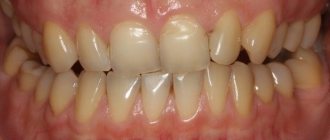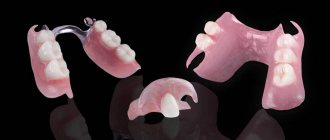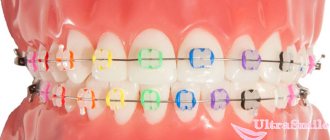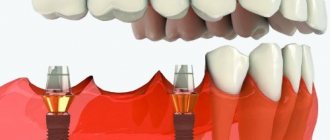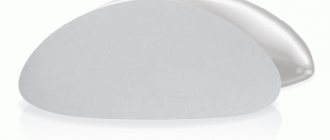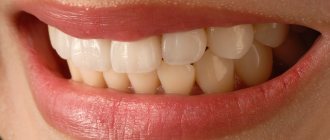Doctor's consultation Since the 30s of the last century, many Hollywood stars have used veneers to create a snow-white and attractive smile. And today microprostheses are actively used in dentistry.
Veneers are thin plates made of composite material or ceramics. They are fixed to the front side of the dentition.
Microprostheses are necessary in the following cases:
- When the color of the enamel changes due to depulpation or taking antibiotics;
- Removal and prevention of fluorosis and carious stains;
- In case of enamel erosion or the presence of cracks and chips;
- To correct gaps between teeth and to even out their shape;
There are two types of veneers: composite and ceramic.
Differences between composite and ceramic veneers
Veneers made of composite material are otherwise called direct - due to the method of creation. The doctor plays the record in 1.5 - 2 hours while the patient is in the dental chair. In some cases, an impression is taken of the teeth and the veneers are cast from the impression in the laboratory.
Direct veneers are extremely firmly connected to the tooth tissue, this is facilitated by the layer-by-layer technology of applying a composite to damaged enamel. It is impossible to tear the created plate from the foundation. The tightness of the composite veneer is extremely high - there is not the slightest gap between the base and the coating that could provoke the growth of pathogenic flora. At the same time, the composite veneer retains its plasticity and does not cause discomfort. Preserving color and transparency for many years, the prosthesis maintains the impression of the naturalness of the restored tooth.
Ceramic veneers or zirconium veneers are made exclusively in a dental laboratory using high-precision impressions. They are attached to the patient's teeth using a specially developed adhesive. There are several known methods for making ceramic veneers: pressing under pressure, casting on a refractor, cutting from a molded blank. These thin plates in finished form also very reliably imitate the appearance of human enamel, so correcting the aesthetics of a smile with such overlays is always successful.
How to navigate the world of veneers?
Are you planning to install veneers, but are you confused by their variety and price? I would like to put veneers on my teeth so that the price suits me, and so that they last for many years, and so that they do not wear down my teeth too much for installation. So is it worth putting veneers on your teeth and how much does it cost to have them done in Moscow? Let's talk about this.
What is a classic veneer?
A classic veneer - from the point of view of aesthetic dentistry, it is such a thin plate that can be made of different materials from ceramics, zirconium dioxide, composites. Usually, in the patient’s understanding, dental veneers are thin plates that are glued to the surface of the tooth and change its shape, color and size. And thus, with the correction of teeth with veneers, a person’s smile miraculously changes.
Features of direct veneers
People choose this restoration method for a number of reasons:
- It's inexpensive and fast. Composite veneers are installed in one clinic visit; there is no need to plan long-term treatment or schedule trips to the dentist. The cost of the composite is much lower than the production of ceramics.
- The removal of enamel from the surface of the teeth is extremely minimal, sometimes only required in places.
- There is a clear similarity between composite veneers and the enamel of natural teeth.
- It is attracted by the high adhesion of the artificial material to living tissues.
The technique has some disadvantages:
- The quality of the final composition greatly depends on the experience and qualifications of the doctor. This drawback, however, is inherent in any result of a dentist’s work.
- Tarnishing of a record over the years. It can be eliminated by polishing the veneer once every six months.
- Changes in the color of the veneer due to frequent consumption of coloring foods and drinks. Cannot be corrected.
- Corrosion of a composite veneer under the influence of ethanol occurs with regular drinking of alcohol and when rinsing the mouth with alcohol-containing rinses.
Life time
Ceramic veneers are more durable than composite veneers. This is determined by the characteristics of the material: ceramics are denser, stronger, and are not subject to staining or changing color or surface texture over time. With proper care, ceramics last for decades. The service life of the composite is limited to five years, which is determined by the properties of the material itself: under the influence of an aggressive environment and mechanical loads, its surface changes, wears out, and becomes porous, which is why the surface of the crown darkens or becomes stained and loses its gloss.
Pros and cons of ceramic veneers
The advantages of silicon oxide overlays are obvious:
- Lack of ability to oxidize, change color, or degrade. Ceramic veneers do not absorb pigments from food and do not disintegrate under the influence of acids and alcohols. They will not show any stains or discoloration throughout their entire service life.
- Ceramic veneers will last for more than a decade if initially installed correctly and handled with care.
- The plate is very durable, despite its microscopic thickness, not reaching even a millimeter.
- Imitation of enamel is the best among other veneering techniques.
Flaws:
- The cost of ceramic veneers is not affordable for every patient.
- The impossibility of quick prosthetics sometimes becomes extremely difficult. A person will have to visit the clinic at least twice: to take impressions and for final installation. In addition, you will have to spend money on making a temporary structure, which will need to be worn until the permanent veneers are glued.
- When preparing teeth for veneers, the doctor may overheat the tooth pulp, which can lead to inflammation and acute toothache.
Porcelain veneers require grinding down of the teeth. Composite veneers do not have high strength and durability. There is a better alternative to all options: install veneers without grinding your teeth Luxneers
Material
Ceramics is used for aesthetic restoration because it is as close as possible in optical properties and appearance to tooth enamel. The surface texture, light reflection, and the degree of transparency of the material are such that the restored crowns look natural.
Dental composite is more often used for filling and functional restoration of crowns. It is used less often in aesthetic restoration: it is not so transparent, the surface texture can change over time (become porous, less smooth). Composite reflects light differently than enamel. Because of all this, it does not look as natural, especially on the upper incisors, for which veneering is most often used. They can stand out and attract attention.
Ceramics and composite differ in strength and durability:
- ceramic plates do not wear off and are resistant to chips, microcracks, and other mechanical defects;
- the composite is not so durable: even with careful handling, it gradually deteriorates and requires regular polishing and periodic re-restoration.
Another selection criterion is color. The color of the installed veneers must exactly match the patient’s own enamel. When using ceramics, the shade is selected with maximum accuracy using a special color scale. For composite compositions there are fewer color gradations, which makes it more difficult to accurately select a shade.
After installation, the plates should not be stained by drinks, foods or darken over time. Ceramics are resistant to color changes: the structure of the material is dense, without pores on the surface, it does not absorb pigments or dyes. The density of the composite is lower. Gradually its color may change; it will stain faster than enamel. Because of this, the restored crowns will differ in appearance from the rest of the teeth.
Reasons for installing veneers
If one or two teeth require restoration, it is more profitable to install composite veneers, but ceramics are not at all prohibited. If there are many cosmetic defects and you need to cover three or more teeth, it is advisable to use porcelain veneers.
General indications for veneering:
- Masking darkening of enamel, the presence of erosive areas, small chips and cracks, stains.
- Correction of hypersensitivity of teeth.
- Improving the appearance of the tooth after treatment of pulpitis or caries. Behind the veneer, like behind a shield, it is possible to hide fillings and tooth darkening as a result of nerve removal.
- Changing the shape of the tooth, giving the effect of uniformity in the row.
- Covering interdental spaces and wide crevices.
When choosing to improve the aesthetics of your smile with veneers, you will have to follow the instructions of your dentist. The doctor has the right to refuse to place veneers on the patient if the following diseases are traced in the anamnesis:
- Bruxism (uncontrollable night grinding of teeth);
- Deformation of gum tissue, periodontal disease, gingivitis, poor sanitary condition of the oral cavity;
- Too massive fillings on the teeth, exceeding the volume of remaining living tissue;
- Malocclusion;
- Allergy to components of the composite mass.
Do you still think that veneers without grinding of teeth Luxneers or composite are better?
Make an appointment
Or call +7(985)532-21-01
Production stages
Composite plates are very quickly installed on damaged teeth. This is explained by the special properties of the material (coposite), as well as the technology for manufacturing the plates and their installation:
- The tooth is lightly ground (the thickness of the removed enamel is 0.3-0.7 mm);
- A special cord is installed between the tooth and the gum to avoid damage to the gum;
- The oral cavity is rinsed with a special solution and dried;
- Next, the dense substance of the composite is applied in layers, each layer is fixed with ultraviolet light;
- The resulting result is leveled and polished.
It must be said that every six months it is necessary to do grinding to maintain their aesthetics.
Where is the best place to place veneers?
It's no secret that aesthetic operations such as the installation of veneers should be carried out only in serious and trusted clinics. From the best specialists. They are professionals in their field, with thousands of successfully performed veneering and aesthetic dental restoration operations behind them.
Why do we offer installation of veneers here, in our clinics?
All-Russian
The rating of private dental clinics in 2022 confirmed
the leadership
of the German Implantology clinics and the “Clinic over 3 years old”.
11,000 of the best
Russian dental clinics from more than 110 cities fought for the right to be the first, and we again became the best in Russia!
The award ceremony took place on September 23, 2022
within the framework of the largest dental exhibition in Russia -
DENTAL EXPO 2019
and
on September 22, 2022
at the
DENTAL EXPO 2020
.
In the category “Clinics up to 3 years of age” - the clinic of the Research Center in Ramenki:
In the category “Clinics over 3 years old” - the clinic of the Scientific Research Center on Kievskaya,
which has been successfully performing dental implantation for more than 9 years:
Which ones are better
It is impossible to say unequivocally that ceramic veneers are better. They are stronger, more durable, and more comfortable. The significant difference in price between composites and veneers sometimes forces one to choose a tooth covering made of a composite material. They can be replaced as needed to benefit your own budget.
Which dental coating to choose depends on the initial condition of the incisors and the patient’s wishes.
Ceramic veneers are recommended in the following cases:
- the need for long-term use of pads;
- the presence of serious visual defects – cracks, chips, dark areas, crooked teeth;
- budget allows;
- There is time to wait for the veneer to be made.
Componers are recommended for patients if:
- it is necessary to urgently correct the visual defect;
- budget is limited;
- need for temporary use.
Rules of care
Modern dental ceramics are as durable as natural tooth enamel. Therefore, you shouldn’t be afraid to treat yourself to nuts or grilled sweets once again, just don’t open bottles with your teeth, and use mouthguards when doing active sports.
Another thing is composite linings. To extend their service life you will have to:
- stop smoking, otherwise your teeth will quickly turn yellow-brown;
- give up coloring foods: beets, wine, strong tea, fresh berries, coffee;
- Use cavity rinses that do not contain ethanol.
Abrasive toothpastes are contraindicated for both ceramic and composite veneers. To restore the smoothness of composite onlays, it is enough to visit the dentist once every 6-12 months for grinding.
Despite the fact that plaque does not form on ceramic linings, regular professional cleaning, at least once every six months, is also necessary in this case. But you need to trust your smile only to professionals!
Remember! Ultrasonic and popular abrasive methods of cleaning teeth Air Flow are strictly prohibited for patients with ceramic veneers. Both procedures violate the integrity of the plates.
Any problems with both composite and ceramic veneers require increased attention. Roughness and steps at the point of contact between the prosthetic material and tooth enamel cannot be ignored. If the veneer is not installed tightly, it may fall off at the most inopportune moment. And any, even the smallest, gap is a gateway to infection and a serious risk of developing caries.
Gums require no less attention. In areas of contact with veneers, they may bleed, swell, and hurt. It is dangerous to ignore such symptoms: in the case of a chronic inflammatory process, the doctor will be forced to remove the linings and start the entire restoration process all over again. To prevent this from happening, at the slightest irritation, make an appointment with a dentist you trust.
Indications for installation of overlays
Composite onlays will help correct any minor enamel defects and aesthetic imperfections of the smile:
- chips;
- enamel irregularities;
- microcracks;
- large gap between the front teeth;
- old darkened fillings;
- stains on teeth that cannot be whitened.
If the patient is categorically not satisfied with his smile, ceramic veneers will be a more effective solution. With their help, you can radically change the situation: create a Hollywood smile, correct wedge-shaped teeth, crowded incisors, and correct your bite. The installation of ceramic veneers is also recommended for worn-out tooth enamel, as well as for too small teeth.
Indications and contraindications
Like any other dental device, plates have indications and contraindications. Installation of overlays is indicated in the following cases:
- a pronounced yellow color of the tooth that cannot be whitened (more often this condition develops with the abuse of coloring foods or drinks, as well as in heavy smokers);
- if after depulpation the tooth color has become dark; with fluorosis lesions;
- in the presence of pronounced defects with a large area of enamel damage;
- with uneven and incorrect placement of teeth in the smile line;
- in the presence of abnormal development of teeth;
- if bleaching procedures to get rid of an unpleasant shade are ineffective;
- if there are old fillings that differ in color from the natural color of the enamel.
The main contraindications for installation are:
- presence of malocclusion;
- if adjacent molars are missing;
- if you have bad habits - biting nails, cracking nuts, opening bottles (such contraindications are relative, after you manage to get rid of negative habits, plates can be installed);
- if the patient suffers from bruxism;
- when leading an overly active lifestyle, engaging in extreme sports;
- if the inside of the tooth is very damaged;
- with pathological abrasion of enamel.
Is there a visual difference
A special scale helps you choose the color of ceramic veneers. The shade of the composite is selected in the same way. If it is chosen correctly, then there is practically no visual difference.
You can find reviews from patients who say that componeers look less natural. However, this indicator largely depends on the professionalism of the clinic, the material used and the experience of the dentist. Therefore, when choosing a medical institution and a doctor, you should carefully study the reviews and study the differences in the photo.
Veneers are made using direct and indirect methods. In the first case, they are done immediately in the dentist’s office, and in the second, they require the use of special technologies. The patient and the doctor can choose the best option – compositers or ceramic veneers. Each has advantages and disadvantages.
What's more expensive?
On average, the price of a ceramic veneer in dental clinics in the capital is almost 2 times higher than the cost of installing a composite onlay. This is understandable, because at least 2 specialists work on creating the plate: a dentist and a dental technician. And in addition to paying for their services, the cost of ceramic veneers also includes depreciation of expensive laboratory equipment and the cost of purchasing the consumables themselves.
It’s easier with composite veneers, since they are made directly in the patient’s mouth by the dentist himself. And since the final result largely depends on the skill of the doctor, the price varies greatly from clinic to clinic. You can get a composite veneer installed by a novice doctor much cheaper than by a professional with a capital “P.” But will the result justify itself?



